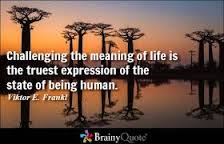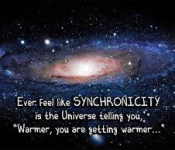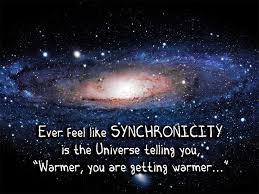Do Humans Seek and Create Meaning (Part 4)?
Author: John Cane, MA
Synchronicity as an Alignment with Patterns and Meaning
In an attempt to further substantiate the idea that human beings seek to create meaning, it might be considered that seeking meaning in relation to synchronicity may perhaps be compared to walking next to a stream and it being the creative flow of consciousness in the universe. I believe that when we seek to create meaning, we gradually align ourselves with the creative flow, eventually stepping in to move with and be at one with the current.
McCauley (2005) states:
When we are engaging in our life purpose, synchronicities will occur to direct and even facilitate our purpose according to our lesson of synchronicity. We need to practice paying attention to synchronicities as they occur. Since one of the components of synchronicity is meaning, we must expend some mental effort at times in order to understand the meaning behind the synchronicity. When we are aware of synchronicities in our life, we gain a glimpse into the very fabric of the Universe. We notice them when they occur, and we attempt to understand their meaning or their message (p. 210).
This relationship and connection with the patterns of the universe can help us to become conversant and be in agreement with our true purpose, allowing us to experience abundance. Here, the creative power of the universe moves with, through and supports us in exercising our gifts and abilities.
As cited by Sperry (2007), Carl Jung defined synchronicity as “the simultaneous occurrence of a certain psychic state with one or more external events which appear as meaningful parallels to the momentary subjective state” (p. 2). Synchronicities are additionally linked to life-changing, and profoundly spiritual encounters. Synchronicities can play a vital part in a person’s development and individual transformation. Some synchronicities have involved happenings believed to be supernatural. Synchronicity is a means or agent that carries and communicates hidden messages through patterns of coincidence. These patterns can have personal meaning to an individual experiencing the coincidence. The interpretation of the messages is influenced by the observations and insights of the person’s memories, experiences, and view of reality. It may be suggested that synchronicity is a way to communicate with creation. “Spirituality encourages and engages in the sharing of collective and personal experiences of understanding and dealing with the self” (Kincheloe & Horn, 2007, p. 660)
Survive, Endure, Experience
Maybe our personal mythologies are just a language of our soul that each of us employs from the limitless realities we experience, yet all of us are a part of the same dream. We may dream differently (content) but share the same feelings (energy and patterns). Are our mythologies our distinct way of communicating in our search for meaning? Dreams are just another “reality” but with limitless creative abilities because we are not restricted by the physical plane and interpretation of the life we hold while awake. There are no physical rules in dreams. ‘Meaning’ may not need an explanation when trying to understand and explain “subject” and “object”. ‘Meaning’ and creativity may be the connecting force between the two. When creating art we become at one with creation and feel a sense of flow and interconnectedness to purpose and personal meaning. I do know from my own experience with art, music, and acting that when I am in the truth of the moment, with sincere intention, I feel as if there is an added energy connecting all things. When I seek and create meaning, I am guided by a force, a sensation, an aura.
Victor Frankl (1985) makes clear how his feelings for wife, who was killed in the concentration camps, gave him a sense of meaning:
We were at work in a trench. The dawn was gray around us; gray was the sky above; gray the snow in the pale light of dawn; gray the rags in which my fellow prisoners were clad, and gray their faces. I was again conversing silently with my wife, or perhaps I was struggling to find the reason for my sufferings, my slow dying. In a last violent protest against the hopelessness of imminent death, I sensed my spirit piercing through the enveloping gloom. I felt it transcend that hopeless, meaningless world, and from somewhere I heard a victorious “Yes” in answer to my question of the existence of an ultimate purpose. At that moment a light was lit in a distant farmhouse, which stood on the horizon as if painted there, in the midst of the miserable gray of a dawning morning in Bavaria. “Et lux in tenebris lucet” — and the light shineth in the darkness. For hours I stood hacking at the icy ground. The guard passed by, insulting me, and once again I communed with my beloved. More and more I felt that she was present, that she was with me; I had the feeling that I was able to touch her, able to stretch out my hand and grasp hers. The feeling was very strong: she was there. Then, at that very moment, a bird flew down silently and perched just in front of me, on the heap of soil which I had dug up from the ditch, and looked steadily at me (pp. 38-39).
About the Author
For over 15 years, John Cane, MA has helped over 100,000 individuals in areas of Self Improvement. John is a Life Coach, motivational speaker and writer who develops and implements confidence and self-esteem workshops in Baltimore, Florida, Georgia, Illinois, New York, North Carolina, South Carolina, and Virginia. With a background in Psychology, he has six certifications in Personal Growth and Development. His Journal Books, ‘Important Things I Remember from My Parents’ are used in schools and as an aid for adults in gaining strength in self-identity in the United States and Europe.
John Cane is the founder of Edge Advantage, Inc. Edge Advantage is a personal development organization dedicated to research-based, practical psychology training. Our focus is on communication, individual performance, and reducing stress. The objective of John’s websites is to bring the most current developments from these areas to those who use them every day, educating in a form that is clear and practical. John is also the webmaster of Self Help Guides Online (.com) and See the Obvious (.com). He is currently pursuing a Doctorate in Psychology at Saybrook University, Oakland, California. His specialization, Psychology of Creativity Studies focuses on finding ways for individuals to experience their potential and realize personal success. John also works with organizations implementing innovative strategies through a systems perspective.






